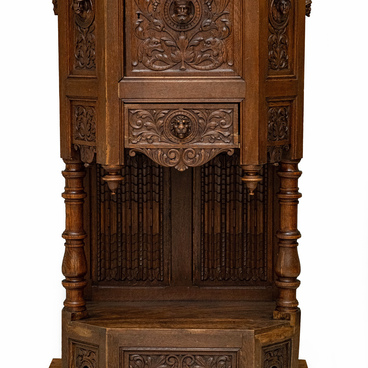The collection of the Sakha Republic National Art Museum features a zushi shrine with the deity Aizen Myōō — Wisdom King of Passion. The exhibit is included in the section “Art of the East.”
Such objects are cult Buddhist accessories. The black lacquer case with two gilded doors on bronze hinges is carved from wood. It is a miniature reproduction of the main altar in the temple and could be placed on a home altar or used during travel. Inside, on a five-step pedestal, there is a golden turtle — a symbol of cosmic order. It supports a red lotus throne with a red-bodied figure sitting on it. It is Aizen Myōō — a deity of love.
Myōō is a wrathful manifestation of one of the Buddhas (Vairochana), who fights against unbelief and the enemies of Buddhism. He has a square angry face, round bulging eyes, a fleshy nose and an open mouth with sharp predatory fangs. His hair stands on end, on his head is the face of a lion, and behind his back is a mandorla — a fiery aura (fire dispels darkness and is a sign of absolute omniscience). In his right hand he holds a vajra (lightning bolt) — a symbol of strength; in his left — a bell. Together they mean the unity of wisdom and method, masculine and feminine principles. In his other hands, there is a red lotus flower of love and compassion, a bow, and arrows — symbols of love (not preserved). Aizen Myōō (Rāgarāja) is the protector of love and marriage, embodying the greatest compassion. He suppresses lust and greed, transforming them into positive energy, and prevents ignorance and evil forces that stand in the way of a person following the path of Enlightenment.
The statuette is realistic, carved with great skill
and attention to every miniature detail. Miniature lacquer zushi shrines are
typical examples of Japanese cult art. The museum’s exhibit is made in the
traditional method: it was carved from wood, painted with black lacquer on the
outside, and covered with gold. The more layers of lacquer were applied, the
more durable and expensive the product became. Workshops for making figures of
deities have always existed at large temples. The circle of philosophical views
of the artists of the East, skilled in a variety of types of artistic crafts,
finds vivid expression in the technique of making objects of worship.









